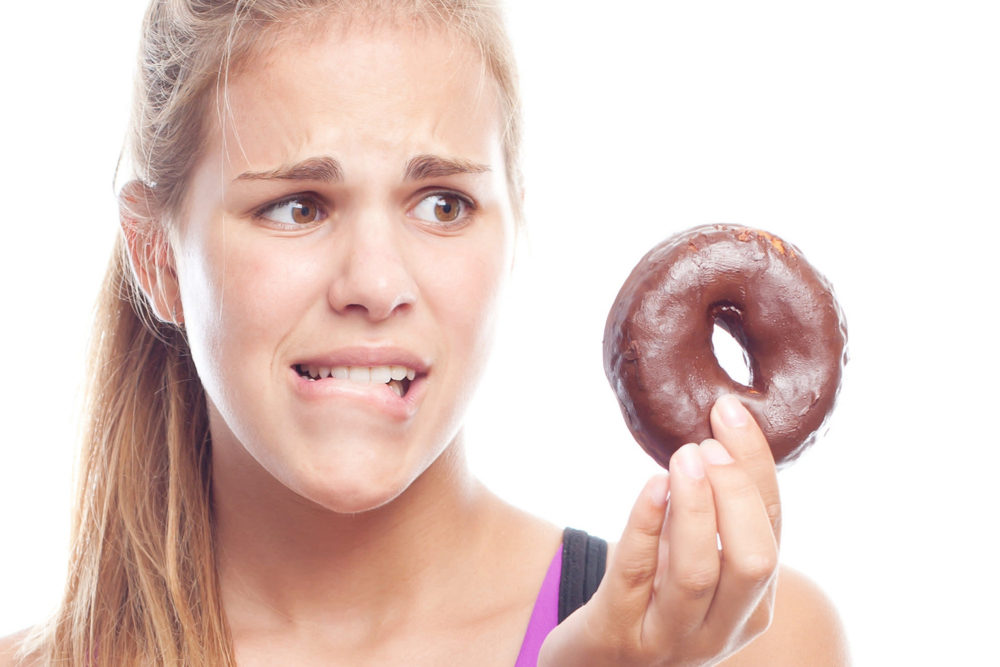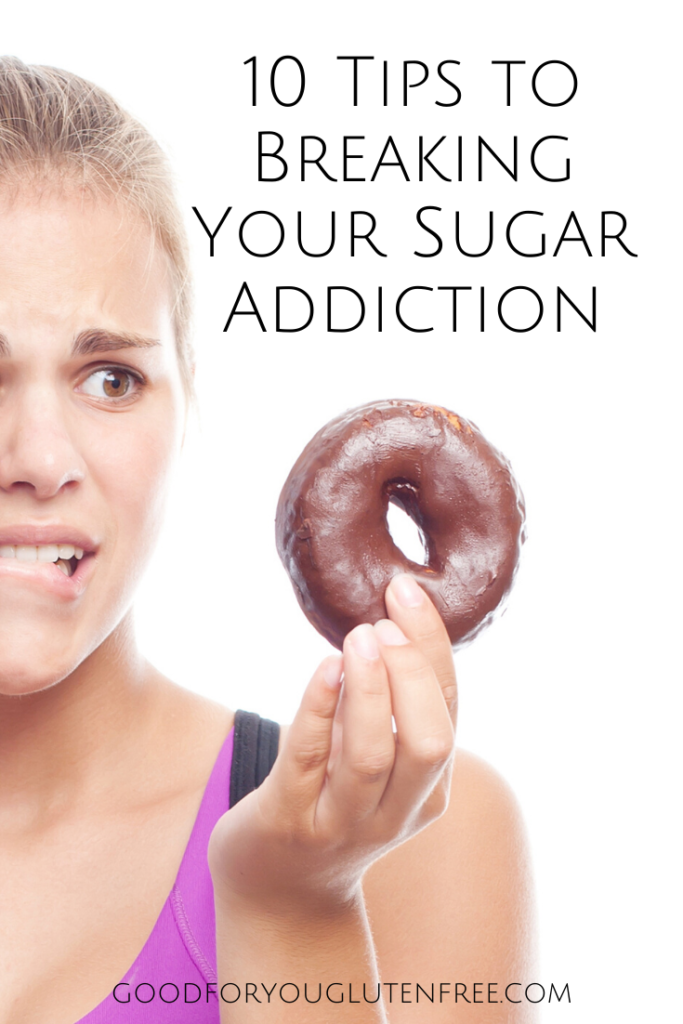
This post, 10 Tips to Breaking Your Sugar Addiction, contains affiliate links. Please read my disclosures. The original post from August 2017 has been updated and re-published by the author.
Sugar addiction is real, my friends.
Even studies show that rats addicted to both sugar and cocaine, when given the option, choose sugar over cocaine 94 percent of the time.
While many experts agree that a little sugar isn’t harmful, almost everyone can agree that the amount we consume today is very harmful. You don’t have to look too far to understand what sugar addiction is doing to our nation.
Skyrocketing rates of obesity, heart disease, and diabetes are proof that sugar addiction is slowly killing all who overindulge in the sweet stuff.
As I said, the problem isn’t when we eat a little sugar here in there. The problem is that we eat sugar all the time. It’s in everything convenient, fast and cheap. It’s found in orange juice, “healthy” yogurts, and in sports drinks like Gatorade that are marketed as “healthy.”
Sugar also is found in probiotic drinks like GoodBelly, and Tropicana Probiotic Juice, which were created to promote healthy gut flora yet are loaded with sugar that feeds the unhealthy bacteria brewing in our bellies.
Related Reading: 19 So-Called “Health Foods” that Aren’t Even Healthy
Sugar also is found in processed foods and in white-refined grains like white rice and white flour. Even sandwich bread (yep, the whole grain kind, too) is often pulverized so much that the carbohydrates in the bread quickly convert to sugar in your body.
Sugar is a highly inflammatory food that overloads your pancreas and spikes your insulin levels. Eating it excessively inches you closer to metabolic diseases such as increased blood pressure, high blood sugar, excess fat around the waist, and abnormal cholesterol – all major risk signs of diabetes, heart disease, and stroke.
On top of it all, every time you eat sugar, your body has to work hard to figure out how to digest it.
Unlike fruit which comes with sugar AND plenty of fiber and nutrients, sugar alone requires your body to call upon its reserves of essential nutrients to digest it. This means sugar pulls vital nutrients away from your body, leaving you feeling sluggish, weak, and even sick!
While it’s easy to see that consuming sugar in excess is bad for your health, we all know that sugar isn’t so easy to give up. We crave sugar. We are ultra-addicted to the sweet stuff.
Natural MD Radio with Dr. Aviva Romm, one of my favorite natural health podcasts, featured an interview with Alexandra Jamieson. The two talked about the importance of getting to the root cause of your cravings. If you can figure out why you’re craving sugar or XYZ food, then you can better equip yourself to overcome those cravings.
4 Root Causes of Sugar Cravings
These are the four root causes of sugar cravings:
1. Bacteria Imbalance
The first root cause of craving is a bacterial imbalance in the gut. Bad bacteria in your gut feed – and therefore craves – more sugar.
Your impulse to reach for sweet foods is your gut telling your brain what it needs. The bad bacteria need sugar to survive. You’re just doing what your gut – or second brain – tells you to do.
To better illustrate how this works, think about the bread-making process. The first three ingredients in bread are yeast, water, and sugar. The water will begin to activate the yeast.
However, you might be wondering what sugar is meant to do. It’s there to give the yeast something to munch on. Yep, yeast gets really excited and bubbly by feeding on sugar, so you’ll get a visual cue that your yeast is active and alive when you add sugar.
Your sugar craving might mean you have a bacteria imbalance in your gut that you must address. You can address it by starving the bacteria by not feeding it sugar for at least three weeks. When the yeast has nothing to eat, it will die.
At the same time, you can begin to repopulate your gut with beneficial bacteria by taking a high-quality probiotic capsule, eating anti-inflammatory foods, and enjoying a fermented food with every meal (kimchi, sauerkraut, kefir, kombucha, or fermented pickles).
Related Reading: The Benefits of Probiotics
Once you achieve bacteria balance in your gut, you can enjoy an occasional sugary treat now and again. However, if you suspect you have candida or bacteria overgrowth in your gut, talk to your doctor.
2. Nutritional Deficiency
It’s been long said that Americans are overfed but undernourished.
In a desperate attempt to compensate for poor nutrition, we often get strong cravings to eat more things like sugar, packaged food, fast food, etc. These products give us a quick burst of energy and make us feel better in the short term. However, long-term, the cravings won’t go away when the foods you’re eating are missing vital nutrients.
To understand if you’re missing vital nutrients, ask your doctor for a blood test. Oftentimes people find their lack of energy is due to a Vitamin D deficiency. Please note that insurance may not cover Vitamin testing anymore. If this happens, I highly recommend getting tested using these at-home vitamin test kits. Knowledge is power!
Your attempt to compensate for the lack of Vitamin D in your diet might have you reaching into the cookie jar to get a quick short-term energy spike.
Another way to combat nutritional deficiencies is to ensure you’re eating plenty of vegetables. Eat as many whole, unprocessed foods as possible. You might find your cravings for sugar dissipate after sipping on green juice each day.
3. Emotional
For many people – er, most of us – it’s hard to separate our emotions from food. We eat to comfort ourselves in times of sadness or as an excuse to indulge in times of celebration. We even eat – a lot – after a hearty workout because we think we deserve it.
The truth is, our emotions can sabotage our efforts to eat healthily. Become aware of the roller coaster of emotions you’re experiencing on a daily basis. Awareness of how your emotions impact your food choices is a powerful step in curbing your sugar addiction.
4. Physical
So many of us are deprived of physical contact – the kind of nourishment that comes from touch, hugs, and cuddling. Humans are hardwired for physical contact, sex, and play.
When our physical needs are unmet, we often crave comfort from highly addictive, sugary foods. A good rule of thumb is to touch more, and eat less.

10 Tips to Breaking Your Sugar Addiction
Once you have identified the root cause(s) of your cravings, you can then move forward in a way that allows you to control your cravings… no longer will your cravings control you.
Perhaps you need more physical touch or emotional support in your life, or maybe there’s something physiologically wrong that needs to be addressed.
Whatever the case, you are well on your way to overcoming your sugar addiction just by understanding and acknowledging the root cause of your cravings.
Once you have acknowledged and addressed the root cause of your cravings, you can then appreciate these 10 tips for eating less sugar and kicking the sugar addiction for good:
1. Avoid Packaged Foods.
Most packaged foods are loaded with white refined flour and added sugars. Instead, eat foods that are whole and fresh, like avocados, berries, and sliced veggies.
2. Avoid Sugary Sodas and Energy Drinks.
These “beverages” are sugar delivery systems. A 20-ounce bottle of Gatorade contains 34 grams of sugar. A can of Coke contains 39 grams of sugar… these two drinks are equally bad for you – don’t be fooled by marketing hype.
3. Avoid Artificial Sweeteners.
It’s been well-documented that diet drinks and artificial sweeteners cause you to gain weight, mainly because they make you crave more sugar. Artificially sweetened beverages are, simply put, counterproductive to your healing.
On top of that, I’ve never seen a study showing someone overcoming a sugar addiction – or losing weight – because they switched from sugar to artificial sweeteners. If such a study existed, you bet Big Food would have made sure you knew about it.
4. Enjoy a Savory Breakfast.
Most people start off their day with sugar topped with sugar and then a side of sugar too. Think about it… cereals, bagels, waffles, and toast are all made with refined grains that convert to sugar in your body. We then top our waffles with more sugar and eat them with a side of sugary OJ.
When we start off our day with sugar, we crave more sugar as the day progresses. If you want to curb your sugar cravings, start your day with a savory breakfast – perhaps some scrambled eggs topped with salsa and sliced avocado.
Related Reading: Gluten-Free Huevos Rancheros
5. Eat Sweet Vegetables.
If you crave something sweet, try eating more sweet vegetables like carrots, sweet potatoes, beets, corn, onions, and squash. Roast these sweet veggies with a little olive oil and sea salt. Try my Healing Carrot Walnut Soup or roasted beets.
6. Enjoy Fruit Minimally.
While fruit contains natural sugars, it also comes with essential nutrients and the fiber your body needs to process the sugar. I suggest limiting fruit consumption until you restore gut balance (important if your bacteria is wonky) and enjoying low-sugar fruits instead, like berries (especially blueberries) and kiwi.
Once your body is restored to good health, fruit can be an excellent source of nutrients and fiber for you – so don’t give it up. Just enjoy fruit within reason.
This is an excellent article from NPR that answers the gnawing question if sugar from fruit is the same as sugar from candy. So many people demonize all sugar, but not all sugar is created equal by your body.
7. Read Labels.
Condiments, salad dressings, coffee creamers, and yogurts contain sugar. Flavored Yoplait Yogurt contains 27 grams of sugar, and of the 170 calories, 108 come from sugar. Eater beware.
8. Eat Whole Grains.
Quinoa, brown rice, millet, and buckwheat (all gluten-free grains) slowly digest in your body vs. rapidly converting to sugar like the white grains. Limit white refined starches like white rice, white bread, potatoes, and cereals, and enjoy a small serving of whole grains each day to help you feel full longer.
9. Drink Up.
When you’re hungry or craving sugar, drink a glass of water with a lemon squeeze or muddled cucumber. We often mistake thirst for hunger or cravings. I find that a cold glass of water helps me feel full and deters me from reaching for the bag of M&Ms.
10. Learn to Cook at Home.
Return to the basics and learn to cook at home (and love cooking at home, too!). Avoid eating an excessive amount of your meals out of the house.
Take an hour daily to cook things you and your family will love. Don’t rush dinner.
Plan your meals ahead of time. Your health is too important to leave in the hands of short-order cooks at fast food restaurants. Health is wealth – keep your priorities straight.
Remember, it takes time when it comes to breaking your sugar addiction. It’s an addiction, after all.
It takes time, self-love, and patience. The first step is understanding that you have a sugar addiction, then understanding the root cause of it, and then taking steps to remediate it immediately.
You can do this. I have faith in you.
P.S. Gluten is highly addictive too. Here are the steps I took to overcome gluten addiction.
Thanks so much! Very helpful and encouraging 🙂
Thank you!
This was very helpful. I can’t wait to read moreof your articles.
Thank you. I’m so glad it helped you in some way!!
Very thorough information here, thank you, this was helpful!